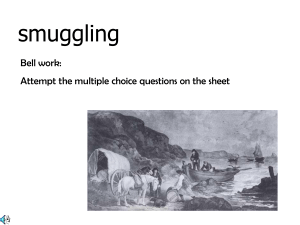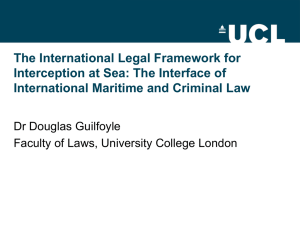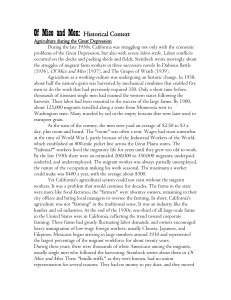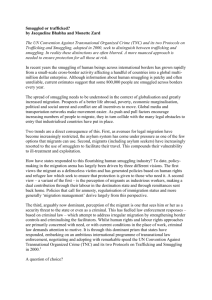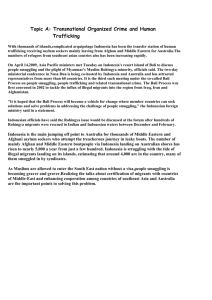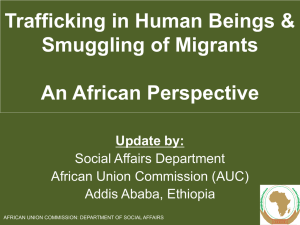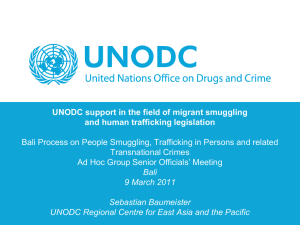presentation Elda Belja - Marsafenet – COST Action IS1105
advertisement
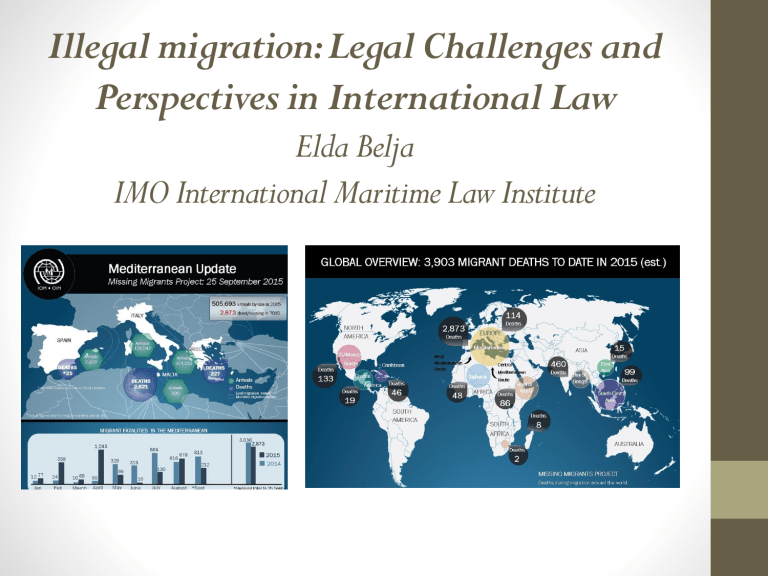
Illegal migration: Legal Challenges and Perspectives in International Law Elda Belja IMO International Maritime Law Institute The GoldenVenture The Golden Venture freighter, overflowing with illegal immigrants, after running aground off the Rockaway peninsula June 6, 1993. The GoldenVenture • 286 Chinese migrants crowded ‘like animals’ had paid (or committed to pay) up to $40,000; • vessel deliberately run aground off the cost of NewYork; • 10 died of drowning or hypothermia, and most survivors deported back to China; • several migrants detained for years in US jails; • few received asylum; • more than 20 were prosecuted for their involvement in the incident including ‘Sister Ping’, the alleged mastermind of ‘a conglomerate built upon misery and greed’ who had amassed over $ 40 millions from migrant smuggling. The Issue • People seem prepared to take huge risks and pay extortionist prices demanded of them by professional smugglers to flee their countries; • With Governments tightening their border controls and the increased difficulty of gaining access to the destination countries, migrants are forced to make use of criminal organizations to achieve their aims; • They are usually transported in unseaworthy vessels, often in atrocious conditions, exposed to life threatening risks, without adequate provisions, on long voyages which result in many fatalities every year; • The deaths are caused by a number of scenarios, including drowning, suffocation, starvation, and even murder. The Issue The crime of migrant smuggling by sea needs to consider a number of inter-related issues: • The interdiction of vessels carrying migrants usually occurs either unilaterally or under treaties; • Due to the subject of the crime being people, as opposed to commodities as in other maritime crimes, this necessarily incorporates considerations of human rights, humanitarian law and refugee law into the fold; • Since unseaworthy vessels are usually used, obligations regarding the rescue of vessels in distress at sea and safety of life at sea must also be considered. The Response The international community has sought to respond to this threat through various means including the use of a number of multilateral and bilateral initiatives. This presentation reviews briefly: • The United Nations Convention on the Law of the Sea (UNCLOS); • The main instrument addressing the threat of migrant smuggling by sea, i.e. the Protocol against the Smuggling of Migrants by Land, Sea and Air (Migrant Smuggling Protocol); • Regional approaches. UNCLOS Territorial Sea Passage of a foreign ship shall be considered to be prejudicial to the peace, good order or security of the coastal State if in the territorial sea it engages in any of the following activities: (g)the loading or unloading of any commodity, currency or person contrary to the customs, fiscal, immigration or sanitary laws and regulations of the coastal State; (art. 19 (2)) A coastal State is entitled to enact laws and regulations, in conformity with international law, regarding innocent passage through the territorial sea, in order to prevent infringement of immigration laws (art. 21(1) (h)). UNCLOS Article27 1. The criminal jurisdiction of the coastal State should not be exercised on board a foreign ship passing through the territorial sea to arrest any person or to conduct any investigation in connection with any crime committed on board the ship during its passage, save only in the following cases: (a) if the consequences of the crime extend to the coastal State; (b) if the crime is of a kind to disturb the peace of the country or the good order of the territorial sea; UNCLOS Contiguous Zone 1. In a zone contiguous to its territorial sea, described as the contiguous zone, the coastal State may exercise the control necessary to: (a) prevent infringement of its customs, fiscal, immigration or sanitary laws and regulations within its territory or territorial sea; (b) punish infringement of the above laws and regulations committed within its territory or territorial sea. (art. 33) UNCLOS High Seas 1. Except where acts of interference derive from powers conferred by treaty, a warship which encounters on the high seas a foreign ship, other than a ship entitled to complete immunity in accordance with articles 95 and 96, is not justified in boarding it unless there is reasonable ground for suspecting that: (d) the ship is without nationality; (art. 110) Migrant Smuggling Protocol • The main instrument addressing the threat of migrant smuggling by sea is the Migrant Smuggling Protocol; • Not an independent treaty but a Protocol to the United Nations Convention against Transnational Organized Crime; • Several of the provisions of the Convention apply mutatis mutandis to the Protocols making them complementary and thus setting out the necessary international cooperation for the suppression and criminalization of migrant smuggling. United Nations Convention Transnational Organized Crime against The Convention represents a major step forward in the fight against transnational organized crime and signifies the recognition by Member States of the seriousness of the problems posed by it, as well as the need to foster and enhance close international cooperation in order to tackle those problems. United Nations Convention against Transnational Organized Crime States that ratify this instrument commit themselves to taking a series of measures against transnational organized crime, including: • The creation of domestic criminal offences (participation in an organized criminal group, money laundering, corruption, and obstruction of justice); • The adoption of new and sweeping frameworks for extradition, mutual legal assistance and law enforcement cooperation; and • The promotion of training and technical assistance for building or upgrading the necessary capacity of national authorities. Migrant Smuggling Protocol • It deals with the growing problem of organized criminal groups who smuggle migrants, often at high risk to the migrants and at great profit for the offenders. • The Protocol aims at preventing and combating the smuggling of migrants, as well as promoting cooperation among States parties, while protecting the rights of smuggled migrants and preventing the worst forms of their exploitation which often characterize the smuggling process. Migrant Smuggling Protocol Article 3(a)‘Smuggling of migrants’ shall mean the procurement, in order to obtain, directly or indirectly, a financial or other material benefit, of the illegal entry of a person to a State Party of which the person is not a national or a permanent resident. Article 3(b) ‘Illegal entry’ shall mean crossing borders without complying with necessary requirements for legal entry into the receiving State. Migrant Smuggling Protocol Article 4 This Protocol shall apply, except as otherwise stated herein, to the prevention, investigation and prosecution of the offences established in accordance with Article 6 of this Protocol, where those offences are transnational in nature and involve an organized criminal group, as well as to the protection of victims of the rights of persons who have been the object of such offences. * The terms organized criminal group and offences which are transnational in nature are defined in the main Convention. Migrant Smuggling Protocol Article 5 specifically provides that migrants shall not become liable to criminal prosecution under the Protocol for the fact of having been the object of conduct set forth in Article 6. 6 (4) Nothing in this Protocol shall prevent a State Party from taking measures against a person whose conduct constitutes an offence under its domestic law. Migrant Smuggling Protocol Article 6 Criminalization When committed intentionally and in order to obtain, directly or indirectly, a financial or other material benefit, the following are to be considered as criminal offences: (a) The smuggling of migrants; (b) When committed for the purpose of enabling the smuggling of migrants: (i) Producing a fraudulent travel or identity document; (ii) Procuring, providing or possessing such a document; (c) Enabling a person who is not a national or a permanent resident to remain in the State concerned without complying with the necessary requirements for legally remaining in the State by the means mentioned in subparagraph (b) of this paragraph or any other illegal means. Migrant Smuggling Protocol The Protocol then also obliges State Parties to criminalize inchoate offences related to those in Article 6(1), such as the attempting to commit an offence, participating as an accomplice, or inciting others to commit an offence listed, as well as establishing the necessary measures providing for aggravating circumstances to the crimes. Smuggling of Migrants by Sea Part II of the Protocol is dedicated to Smuggling of Migrants by Sea Article 7 Cooperation States Parties shall cooperate to the fullest extent possible to prevent and suppress the smuggling of migrants by sea, in accordance with the international law of the sea. Smuggling of Migrants by Sea Article 8 Measures against the smuggling of migrants by sea If a flag State has reasonable grounds to believe that a vessel flying its flag, claiming its registry without authorization or is without nationality and is engaged in the smuggling of migrants by sea, the flag State may request the assistance of other State Parties in order to prevent the use of the vessel for migrant smuggling. State Parties are under an obligation to give such assistance as is possible within their means. Smuggling of Migrants by Sea Article 8(2) permits a State Party which has reasonable grounds to suspect that a vessel flying the flag of another State Party is engaged in migrant smuggling by sea, to request confirmation of registry, and upon confirmation request authorization to take appropriate measures necessary. These may ‘inter alia’ include authorization from the flag State to board and search the vessel, and if evidence of migrant smuggling by sea is found, to take any suitable actions necessary with respect to the vessel, the cargo and the people on board. Smuggling of Migrants by Sea State Parties must respond to any request for a confirmation of registry, a determination if the vessel is entitled to fly its flag, or any authorization requested by another State Party expeditiously according to Article 8(4). A State Party that has taken any measure in accordance with paragraph 2 of Article 8 shall promptly inform the flag State concerned of the results of that measure. Smuggling of Migrants by Sea Para 5 retains the principle of exclusive flag State jurisdiction while endeavouring to facilitate cooperation between the requesting State and the flag State. It grants the flag State the right to subject any authorization given to conditions which must be mutually agreed. Smuggling of Migrants by Sea Para 7 allows a State Party that has reasonable grounds to suspect that a vessel is engaged in the smuggling of migrants by sea and is without nationality or may be assimilated to a vessel without nationality to board and search the vessel. If evidence confirming the suspicion is found, that State Party shall take appropriate measures in accordance with relevant domestic and international law. Smuggling of Migrants by Sea Article 9 Safeguard Specific safeguard provisions are found in Article 9 of the Protocol which require the boarding State to ensure the humane treatment and safety of persons aboard and that any measures taken are environmentally sound. Compensation will be due for any loss or damage that occurs during any measures taken under Article 8. Para 3 ensures that the boarding procedure remains in conformity with the international law of the sea and preserves the general principle of the primacy of flag State authority. Smuggling of Migrants by Sea Part III of the Migrant Smuggling Protocol deals with the issues of prevention, cooperation and other measures. It implements several necessary support provisions including provisions related to information, border measures, security and control of documents, legitimacy and validity of documents, training and technical cooperation, as well as considering the conclusion of bilateral and regional arrangements to combat migrant smuggling by sea and enhance the provisions of this Protocol, among others. EU Action Plan against Migrant Smuggling (2015 - 2020) The European Agenda on Migration, which was adopted by the European Commission on 13 May 2015, identified the fight against migrant smuggling as a priority, to prevent the exploitation of migrants by criminal networks and reduce incentives to irregular migration. The Agenda set the goal to transform migrant smuggling networks from 'low risk, high return' operations into 'high risk, low return' ones. EU Action Plan against Migrant Smuggling (2015 - 2020) The European Agenda on Security, adopted by the Commission on 28 April 2015, also singled out cooperation against the smuggling of migrants inside the EU and with third countries as a priority in the fight against organized crime networks. The Action Plan against Migrant Smuggling sets out the specific actions necessary to implement the two Agendas in this area, and incorporates the key actions already identified therein. EU Action Plan against Migrant Smuggling (2015 - 2020) Revision of EU Legislation on Migrant Smuggling In 2002, the EU adopted rules to crack down on migrant smuggling, the so-called 'Facilitators Package' which is composed of Directive 2002/90/EC establishing a common definition of the offense of facilitation of unauthorised entry, transit and residence, and Framework Decision 2002/946/JHA on the strengthening of the penal framework to prevent the facilitation of unauthorised entry, transit and residence. EU Action Plan against Migrant Smuggling (2015 - 2020) Revision of EU Legislation on Migrant Smuggling The Commission however will make, in 2016, proposals to improve the existing EU legal framework to tackle migrant smuggling, which defines the offence of facilitation of unauthorized entry and residence, and strengthen the penal framework. It will seek to ensure that appropriate criminal sanctions are in place while avoiding risks of criminalisation of those who provide humanitarian assistance to migrants in distress. EU Action Plan against Migrant Smuggling (2015 - 2020) Identifying, capturing and disposing of vessels To prevent and clamp down on migrant smuggling by sea, systematic efforts will be undertaken to identify, capture and dispose of vessels intended to be used by smugglers. A list of suspicious vessels likely to be used in the Mediterranean will be set up. This will include, for instance, registered vessels at the end of their lifetime and foreseen for scrapping. The Commission and the relevant EU Agencies, in particular Frontex, will provide to the Member States financial and technical support to tow boats to the shores and scrap them. EU Action Plan against Migrant Smuggling (2015 2020) Other Specific Actions • IMPROVED GATHERING AND SHARING INFORMATION; OF • The Commission will evaluate, in 2016, and consider a possible revision of the existing EU legislation on Information Liaison Officers to enhance their ability to obtain and share relevant information. • ENHANCED PREVENTION OF SMUGGLING AND ASSISTANCE TOVULNERABLE MIGRANTS; • The Commission will launch a consultation, in 2016, and impact assessment on the possible revision of Directive 2004/81/EC on residence permits issued to victims of trafficking in human beings and to smuggled migrants cooperating with authorities. EU Action Plan against Migrant Smuggling (2015 2020) Other Specific Actions • STRONGER COOPERATIONWITH THIRD COUNTRIES; • Close co-operation with third countries along the entire smuggling route is essential for targeting migrant smuggling and for ending impunity through effective investigation and prosecution. • The EU aims to encourage partner countries to become Parties to the Convention on Transnational Organised Crime and the Migrant Smuggling Protocol. To this end, the Commission will provide funding for projects supporting third countries in enacting legislation in line with the Protocol. Regional Strategy for Combating Trafficking in Persons and Smuggling of Migrants 2015-2020 • The Central and West Africa regions are considered points of origin, transit and destination for victims of human trafficking and smuggling of migrants; • UNODC Executive Director Yury Fedotov highlighted the low conviction rate reflecting the impunity still associated with these crimes and called for a global synergy among stakeholders, whether they are members of Governments, parliamentarians, prosecutors or representatives from civil society and the private sector. • The new Regional Strategy aims to assist the affected countries in dismantling the criminal networks while at the same time protecting the victims of these crimes. Regional Strategy for Combating Trafficking in Persons and Smuggling of Migrants 2015-2020 It includes the following goals: • Improving national and regional coordination and cooperation; • Enhancing information and data, and ensuring this is kept upto-date; • Strengthening the involved States' legal frameworks and public policies; • Building the capacity of the region's criminal justice systems; • Providing support to victims of human trafficking and smuggling of migrants; and • Raising awareness on these issues in the region.
